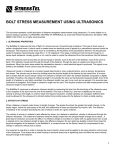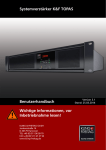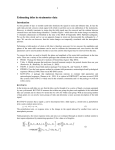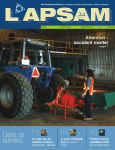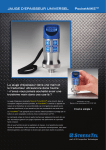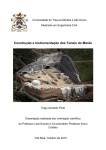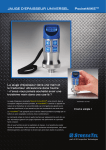Download View - IRSST
Transcript
Hani S. Mitri July 2002 R-308 ÉTUDES ET RECHERCHES Design and Development of a New Rockbolt Load Measuring Device REPORT (The Institut de recherche Robert-Sauvé en santé et en sécurité du travail (IRSST) Occupational Health and Safety Research Institute Robert-Sauvé) is a scientific research agency committed to the identification and elimination at the source of occupational hazards, and the rehabilitation of workers who have suffered occupational injuries. With funding provided by the Commission pour la santé et la sécurité au travail du Québec (CSST, Québec Occupational Health and Safety Commission), the IRSST conducts, funds and contracts research aimed at reducing the human and financial costs of occupational accidents and diseases. For up-to-date information on research conducted or funded by the IRSST, subscribe to Prévention au travail, the free magazine published in conjunction with the CSST. 1-877-221-7046 Reports describing the results of Institute research are available upon request from the Communications Division or free of charge on the Institute’s Web Site.. Legal Deposit Bibliothèque nationale du Québec 2002 IRSST - Direction des communications 505,West De Maisonneuve Blvd, Montreal (Quebec) H3A 3C2 Telephone : (514) 288-1551 Fax: (514) 288-7636 [email protected] www.irsst.qc.ca © Institut de recherche Robert-Sauvé en santé et en sécurité du travail July 2002. Hani S. Mitri, Department of Mining, Metals and Materials Engineering, McGill University ÉTUDES ET RECHERCHES Design and Development of a New Rockbolt Load Measuring Device REPORT Clic Research www.irsst.qc.ca This publication is available free of charge on the Web site. This study was financed by the IRSST. The conclusions and recommendations are those of the author. TABLE OF CONTENTS Acknowledgement ..........................................................................................................................II Summary ......................................................................................................................................... 1 1. INTRODUCTION................................................................................................................... 2 2. REVIEW OF ROCKBOLT LOAD MONITORING TECHNOLOGIES .............................. 2 3. OBJECTIVES ......................................................................................................................... 6 4. DESCRIPTION OF TEST RIG .............................................................................................. 6 5. PRINCIPLES BEHIND THE LOAD MEASUREMENT TECHNIQUE .............................. 9 6. DESIGN OPTIMIZATION FOR THE MINING ENVIRONMENT TO OVERCOME THE EFFECTS OF CORROSION, TEMPERATURE VARIATION AND SEVERE HANDLING.......................................................................................................................... 14 7. FIRST PILOT IN SITU PROGRAM.................................................................................... 20 8. FURTHER MODIFICATION AND OPTIMIZATION OF THE SAFEBOLT SYSTEM IN LIGHT OF THE IN SITU PILOT TESTS ............................................................................ 30 9. SECOND PILOT IN SITU PROGRAM............................................................................... 33 10. CONCLUSIONS ................................................................................................................... 41 APPENDIX A: SAFEBOLT USER’S MANUAL ....................................................................... 43 i Acknowledgement This work was made possible thanks to the financial support of l’Institut de recherche RobertSauvé en santé et en sécurité du travail (IRSST). Their financial support is gratefully acknowledged. I would like to acknowledge with many thanks the help of my research group: Joseph Marwan, Research Associate in Mining Engineering at McGill, for his uninterrupted devotion and hard work on this project, Wilfrid Comeau, Adjunct Professor, who was instrumental in the design and construction of the test rig, and James Davison, Research Assistant, who helped in many aspects of the project and notably the design and assembly of the readout unit. The field demonstration and validation of the SAFEBOLT technology in underground mines was made possible thanks to the participation of Quebec underground mines, namely Bousquet, Doyon and Niobec. In particular, I would like to thank Mr. Paul Gauthier and Mr. Alain Mercier from the Bousquet mine, Mr. André Harvey and Mr. Robert Marchand from the Doyon mine, and Mr. Martin Lanctôt and Mr. Steve Thivièrge from the Niobec mine. I very much appreciate the help and cooperation of the underground operators during the field visits. Hani Mitri iii Summary A new technology for the measurement of axial load on rockbolts and rebars in underground mines has been designed and developed in the laboratory. The technology is known as SAFEBOLT (Stress And Force Evaluator in BOLTS). The SAFEBOLT system consists of three components: 1) the SAFEBOLT device installed in the bolt head, 2) a readout unit, and 3) a connecting cable. A special test rig was constructed in the laboratory to enable the calibration and verification of the instrumented bolt before they are sent to the mines for installation. Three underground mines have participated in the project, namely Doyon, Bousquet and Niobec. Both mechanically anchored rockbolts and rebars were instrumented and installed in the field. The SAFEBOLT instruments were successfully fabricated and installed on rockbolts and rebars of 5 to 7 foot-long. The lessons learned from the first field trials helped to improve the design of the instrument connector on the bolt head to sustain the severe handling during the installation, and subsequent effects due to nearby blasting. Field installations show that SAFEBOLT technology has the potential to become an excellent tool for monitoring the load on bolts, as it is simple to use, reliable and has now a rugged construction. The report highlights the features and limitations of SAFEBOLT technology. A user’s manual is presented at the end of the report. 1 1. INTRODUCTION More often than not, rockfalls in underground mines can result in serious injuries, if not fatalities. Rockbolts are used extensively in underground mines as primary supports to hold the rock mass and provide a safe working environment. They are installed in areas like mine shafts, ramps, drifts, cross cuts, draw points and intersections. In civil engineering, rockbolts are equally widely used in projects like tunnelling of all sorts and hydroelectric power stations. Because of their important role as primary rock support, it is often crucial, for safety reasons, to ensure that the rockbolt is not carrying excessive load and/or that it is not near failure. There are many situations in underground mines where such a concern may arise, for example, in permanent installations like an underground warehouse where men are working under a rockbolted roof, or at important intersections and on main levels where miners pass by regularly every shift. The only test practised by the mines today to ensure that the rockbolt is effective is by applying a torque to the bolt head (nut) using a torque wrench. A torque is applied until the nut starts to turn and the measured torque can then be indirectly related to the load on the bolt. The method is rarely used in metal mines since, more often than not, the bolt head breaks during the test as a result of rust, and the bolt is lost. The need to measure the rockbolt load has been recognised by researchers and new measurement techniques were successfully developed and became commercially available. In spite of this, there is hardly any use of them in Quebec’s underground mines. A recent study by the applicant (Mitri, 1998) of the instrumentation products available on the market for measuring rockbolt loads in situ revealed that such products are either not suitable for mining applications, or too expensive for an operating mine, or both. 2. Review of rockbolt load monitoring technologies 2.1 Vibrating wire instrumented rockbolts Vibrating wire has been used in instrumented rockbolts since the seventies. The design concept of the vibrating wire requires that it be anchored from its ends inside the hollow portion of a cylindrical gage body, and it has an adjustable lower member (see Figure 1). Rotation of the adjustable member changes the tension in the wire and as a result its frequency of vibration. The cylindrical gage body is attached to a rockbolt. Forces acting on the rockbolt embedded in the rock cause the rockbolt and the gage body to elongate (hence the wire). By noting variations in the frequency of the wire from an initial setting, the change in the amount of force the rockbolt is subjected to can be determined. A rotatable pick can be inserted through a hole in the lower adjustable member to mechanically pluck the wire. The readout of the vibrations from the plucked wire may be accomplished by a mechanics stethoscope held against the gage or by an electrically operated pickup head, which engages the vibrating wire. IRB Bolt The Instrumented Rock Bolt Model IRB is using the vibrating wire technology to monitor the load in rockbolts. The IRB can be used to replace hollow core load cells to measure load transfer from the strata to the walls in tieback wall applications. The IRB is a standard, mechanically anchored, expansion shell type bolt. The heart of the system is a vibrating wire strain gage mounted in a hole along the central axis of the bolt. 2 Vibrating wire Cable to readout unit Figure 1: Typical vibrating wire strain gauge 2.2 Vibrating wire load cells The vibrating wire load cells are composed a set of three vibrating wire gages mounted parallel to each other equally spaced in a ring in a cylinder of heat-treated steel alloy. When load is applied on the cell, change in the tension of the gages causes change in the frequency that is induced by a coil/magnet. The average of the readings from the sensors represents the mean load on the anchor, minimizing the effects of eccentric loading. Steel housing with O-ring seals covers the cell and protects the gages from impact damage and water infiltration. For the most reliable results, the bearing plates should be cast with its upper and lower face flat and perpendicular to the anchor and the anchor should be centralized. The bearing plates help to keep distributing load on the anchor without bending or yielding. In side housing have a lightning protection to prevent the sensor from electrical shock and a temperature device to compensate for temperature variations in the sensors. The vibrating wire load cells are used to measure loads in tiebacks, anchors, struts and rockbolts. 2.3 Electrical resistance strain-gauged rockbolts (Figure 2) Sentinel monitoring rockbolt The "Sentinel" Integrity Monitoring range of reinforcement products is a modified reinforcement tendon which can signal to the mine operator whether it is broken and, if so, where. Bolt failure can occur due to overloading and/or corrosion. Once installed, a "Sentinel" bolt is read by inserting a simple probe connected to a strain meter into an environmentally protected sleeved socket at the end of the bolt. The strain meter reading gives a clear indication of bolt integrity. Strain Gauged Rockbolts Strain gauged rock bolts are used to measure the distribution of bolt loads in fully encapsulated systems. Nine pairs of diametrically opposed strain gauges are mounted on the surface of the rockbolt along its length to provide both axial and bending strain profiles. Standard lengths for strain gauged rock bolts are 1.8, 2.1 and 2.4 metres. 3 Direction of strain Backing material Connecting wires Figure 2: Typical electrical resistance strain gauge 2.4 Electrical resistance strain-gauged load cells Strain gauged load cell structure is cylindrical or ring shaped, and is precision machined from a material such as stainless steel. The physical size of the structure controls the deflection that it experiences under load, and therefore the capacity rating of the cell. Load cells designed for higher force values are typically physically larger than sma1l capacity cells. The load-sensing element is a spool of high strength heat-treated steel that withstands in the severe environments normally associated with construction activity. Electrical resistance strain gauges are bonded in full bridge configurations to the periphery of the spool for temperature stability and for compensation of eccentric loading. When load is applied on the cell, the strain gages output an electric signal a corresponding change in its resistance. This signal is transmitted to the readout. The readout processes and displays a reading. The load cells are designed for obtaining longterm stable readings and enduring severe environment. A multi-pin connector terminates the signal cable. The load cell has a noise filtering device and a lightning protection that is mounted inside the cell. Engineering applications of load cells include: measurement of load in struts, tiebacks, rockbolts and anchors. 2.5 Mechanically-gauged instrumented rockbolts Rotabolt Rotabolt works on the principle of elongation as it proportionally relates to the bolt load. Rotabolts have a load-indicating cap on the top of the fastener head. This cap becomes restricted and 'not able to turn' when the bolt load is achieved. 4 A gauge pin of the same basic material as the parent fastener is positively anchored in a short centrally drilled hole and the Rota-load indicator, which is free to rotate on the pin, is set at a prescribed air-gap to the head of the machined fastener. The dimension of this air-gap is set according to the percentage yield stress selected. The assembly is protected from contamination by a control cap, which clips securely on the Rota-load indicator and it is this knurled cap, which may be rotated by hand or tool when the fastener is not fully stressed. Within the cap, the integrity of key components is maintained by specially compounded grease. When the fastener is loaded, the air-gap closes down as a result of the stretch that occurs. At the point where the Rota-load indicator may no longer be rotated by hand the correct load setting has been achieved. 2.6 Measuring a bolt load with ultrasound Bolt Mike II, Bolt Gage III and the StressTel The StressTel BoltMike model SMII is a stand-alone ultrasonic load-monitoring instrument that can accurately read load within the elastic region of any fastener material. This system comes with an internal calibration bar traceable to the NIST. 2.7 Concluding Remarks The above brief review has attempted to classify the methods for the monitoring of rockbolt loads on the basis of the load-measurement principle. No attempt is made here to compare the features and limitations of load monitoring products supplied by different manufactures. This is beyond the scope of the present work. As can be seen, the load on a rockbolt can generally be evaluated either by installing a device inside the bolt to sense the axial strain or the elongation of a specified length of the bolt, or by attaching an external device around the bolt head to sense the compressive reaction force of the rockbolt load on a reaction plate. To recap, rockbolt load can be monitored using the following technologies: a. Vibrating wire systems • IRB bolt • Vibrating wire load cell b. Electrical resistance strain-gauges • Sentinel monitoring rockbolt • Strain Gauged Rockbolts • Electrical resistance gauged load cells c. Mechanically gauged rockbolt • Rotabolt d. Ultrasonic • Bolt Mike II, Bolt Gage III and the StressTel 5 This report concerns itself with the design and development of a new rockbolt load-measuring device, called SAFEBOLT (Stress And Force Evaluator in Bolts). As will be briefly described in this report, the technology is based on the electrical resistance strain gauge inserted in the bolt head. Details of the device design and its fabrication process are protected information under a U.S. patent application (Mitri, 2001), and therefore will not be presented here. 3. OBJECTIVES The goal of this research activity is the design and development of a new instrumentation technology called SAFEBOLT (Stress And Force Evaluator in BOLTs) for the measurement of the axial load in the rockbolt/rebar in situ, i.e. after if has been installed in the ground. The SAFEBOLT system consists of three components: 1) the SAFEBOLT device installed in the rockbolt head, 2) a readout unit, and 3) a connecting cable. The long-term objective of this work is to make the SAFEBOLT system commercially available to the Quebec mining industry at an affordable cost, while keeping its attractive features of being easy to use, reliable, precise, and well adapted to harsh conditions of mining underground. The following are the milestones of this research activity: 1. Design and build a test-rig for the testing and calibration of the new instrument after it has been inserted in the rockbolt head. 2. Establish the principles behind the load measurement technique, and its precision and tolerance levels. 3. Design optimization for the mining environment to overcome the effects of corrosion, temperature variation, and severe handling. 4. Pilot installation program. Instrumented rockbolts are installed in three underground operating mines in Quebec. Training of the mine personnel on how to monitor the rockbolt loads. 5. Further modification and optimization of the SAFEBOLT system in light of the monitoring results from the pilot tests. 6. Second pilot installation program of modified SAFEBOLT-instrumented rockbolts. 7. Final design revisions 8. Production of user’s manual. 4. DESCRIPTION OF TEST RIG A test rig has been designed and constructed in the laboratory in order to enable the testing and calibration of the SAFEBOLT instrumented rockbolts and rebars. The rig frame is entirely made of steel; it consists of three equally spaced reaction rods, and attached at each end to a circular reaction plate with a central hole; see Figure 3. This test rig has a self-reaction capacity of 32 metric tonnes (36 U.S. tons), which makes it capable of accommodating a wide range of commercially available rock bolts and rebars used in underground mines. As can be seen from Figure 4, the test rig is placed and used in a horizontal position to facilitate the handling of bolts, and the instrumented bolt is inserted from the hydraulic jack (head) end through the end plate on the left side of the rig. Once placed in the test rig, a rockbolt/rebar reaction plate is placed and a locking nut is screwed onto the bolt head (Figure 4). The other end of the bolt is fastened with a grip (Figures 5 and 6) behind the circular reaction plate. Specialized grips were fabricated for the 5/8-inch rockbolt and the ¾ inch rebars. 6 Figure 3: Self-reaction test rig for the calibration of SAFEBOLT instrumented rockbolts and rebars 7 Reaction plate Nut 32-tonne hydraulic jack Rockbolt head Plate Figure 4: Reaction plate and hydraulic jack Part 2 Socket cone 5/8’’ Rockbolt Part 3 Gripping cone Part 7 Figure 5: Description of the SAFEBOLT system and test apparatus 8 Part 1 Rebar Figure 6: specialized gripping for the rebar 5. PRINCIPLES BEHIND THE LOAD MEASUREMENT TECHNIQUE 5.1 Load Calculation If the axial strain ε at the bolt head is known, it is possible to calculate the axial load, P as follows (Popov, 1978) P = ε.Eb.Ab [1] Where Ab is the cross sectional area of the bolt and Eb is the modulus of elasticity of the bolt material. The underlying concept of the SAFEBOLT technology is to monitor the axial strain at the bolt head. Once this quantity is measured, the axial load can be calculated for a given bolt size and material. 5.2 SAFEBOLT System Components Figure 7 illustrates an underground excavation with rock supports installed in the roof. The SAFEBOLT system consists of the following components: 1. Gauge device in the bolt head (Figure 8) 2. Portable readout unit, which is basically a signal indicator (Figure 9) 3. Multi-wire connecting cable, permanently attached to the readout unit (Figure 8) 9 Connecting cable SAFEBOLT device SAFEBOLT readout unit Figure 7: SAFEBOLT system components Nut Bolt head SAFEBOLT device connector Connecting cable Figure 8: SAFEBOLT device embedded in the bolt head and connected to cable 10 LCD display Figure 9: Readout unit 5.3 How it works To monitor the axial load in a SAFEBOLT-instrumented bolt, the user first hooks the SAFEBOLT-instrumented bolt head to the readout unit via the cable to take the initial signal reading, A, before the installation of the bolt, i.e. before any load is applied to the bolt. Such signal represents the zero strain or gauge balancing factor. As the load is applied to the bolt (either in the laboratory or in the field), the readout unit will register a signal of magnitude R. Thus the axial strain due to applied load is represented by the quantity R-A. The axial strain can be written as a function of (R-A). Thus, ε = F [(R-A)] [2] Referring to Equation [1], the axial load, P can be written as P = F [(R-A), Ab, Eb] [3] The above equation allows for the calculation of the bolt axial load, P. It can be rewritten as: P (tonnes) = [R-A] ×B [4] Where A= Gauge bridge balancing factor, obtained from the initial signal reading when connected to the SAFEBOLT device before loading. The value of A could be negative or positive. B = Readout unit calibration constant, obtained from the calibration of the SAFEBOLT device as will be explained below. B is a function of Ab and Eb. 11 It should be noted that Equation [4] is linear, and is valid only in the linear elastic range of the bolt load. The elastic limit or yield load of the bolt Pe can be substituted in the above equation to determine the elastic limit reading Re beyond which the bolt can be said to be in the yielding range. For a given bolt type, the yield load, Pe is known. Thus, Re = Pe/B + A 5.4 [5] SAFEBOLT device calibration and instrument precision The purpose of device calibration is to establish the value of the constant B. First, a standard strain meter is used to perform a verification test to ensure that the device is working properly as a strain sensor after it has been installed in the bolt head. In a calibration test, the instrumented bolt is placed in the test rig, fastened at both ends, and then subjected to axial load using the hydraulic jack and pump system as shown in Figure 10. The load is applied incrementally and is measured directly from the pressure gauge dial. In order to avoid the development of permanent (plastic) deformations in the bolt, the maximum applied load is not greater than 80% of the nominal elastic limit or yield load. Using the readout unit, the SAFEBOLT device signal readings R are taken after each load increment. Initially, one loading cycle was applied to obtain the data points necessary for the calibration. However, in response to feedback from the mines about the repeatability of the laboratory results in the field, it was decided to apply two loading cycles in the calibration tests to ensure that the signal readings are reproducible. As expected, the application of two loading cycles proved that there is no hysterisis behaviour in the steel bars for the range of loading applied. All bolts calibrated for the second in situ pilot program were calibrated with data points from two loading cycles. The data points are plotted on an x-y diagram, whereby the x-axis is R-A, which represents the axial load function in Equation 3, and the y-axis is the actual load, P, measured directly from the hydraulic loading system. The net readout measurements (R-A) are plotted versus the applied load for each SAFEBOLT instrumented rockbolt. Linear regression was then used to obtain a best-fit line representing the bolt load equation. Initially, the regression was conducted for a best-fit line of the equation Y= bX+C [6] Where, Y= applied load X= (R-A) b= B as defined in Equation 4 This type of regression led to a constant C, which is the intercept of the best-fit line with the Yaxis. All calibration test results for the bolts of the first pilot in situ program were fitted with equation [6]. 12 Theoretically, however, when R-A=0, the load P must be zero. Therefore, for all the bolts of the second in situ pilot program (and future work), it was decided to adopt a best-fit equation of the type (refer to Figure 11): Y=bX [7] The standard error SE in the estimation of the load Y is calculated for each calibrated bolt. On average, it is found that SE= ± 0.05 tonnes. SAFEBOLT device Connecting cable Readout unit Figure 10: SAFEBOLT system calibration setup 7.0 6.5 6.0 Loading Reloading 5.5 5.0 Load (tonnes) 4.5 4.0 3.5 3.0 2.5 2.0 1.5 1.0 0.5 0.0 0.0 0.5 1.0 1.5 2.0 2.5 3.0 3.5 4.0 4.5 5.0 5.5 6.0 6.5 7.0 R-A Figure 11: Obtaining the constant B using linear regression line fit of calibration test data 13 6. 6.1 DESIGN OPTIMIZATION FOR THE MINING ENVIRONMENT TO OVERCOME THE EFFECTS OF CORROSION, TEMPERATURE VARIATION AND SEVERE HANDLING Effect of corrosion More often than not, the underground mine environment is highly corrosive. This is particularly true with massive sulphide ore deposits. Therefore, it was necessary to ensure that the SAFEBOLT device has adequate resistance to corrosion. As the device is fully encapsulated in the bolt head, there was little concern that the sensor itself corrodes. However, the readings are taken at the bolt head via the device connector, which is exposed. In order to avoid possible corrosion of the device connector, which is exposed at the bolt head (Figure 8), a gold-plated connector was selected, which comes with a gold-plated screw-on cap. Furthermore, a thin rubber ring placed in the connector base ensures that the screw-on cap will completely shield the device head from any corrosive environment. 6.2 Effect of temperature variation All calibration tests were conducted in the laboratory where the temperature is in the range of 24 to 26°c. Large temperature variations in the field can seriously affect the accuracy of the load calculation results, and the non-mechanical strain component due to temperature drop (shrinkage) or temperature rise (elongation) must be accounted for. If the temperature during calibration is Tc, the ambient temperature in the mine is Ta, then the thermal strain ε T induced in the strain gauge is given by: εT = α . ∆T [8] where α is the coefficient of thermal expansion of the strain gauge material, and ∆T= Ta-Tc [9] The apparent (or artificial) load caused by this strain component, which should be eliminated from the load calculation is given by: ∆P = εT . E. Anet [10] where E = modulus of elasticity of the rockbolt material, and Anet = net cross sectional area of the bolt at the location of the strain gauge The corrected load value is then determined from: P(corrected) = (R-A). B - ∆P [11] The apparent load values were calculated for the 5/8 inch rockbolt and the ¾ inch rebar for the range of ambient mine temperature from 10 to 40 °c. The following data were used: 14 α E Tc = 16.7 x 10 –6 = 200,000 MPa =25°c Substituting for the above data, one obtains: ∆P (in metric tonnes) = 0.056 (Ta –25) = 0.087 (Ta –25) for the 5/8 inch rockbolt, and for the ¾ inch rebar [12] [13] The above equations are plotted on Figure 12. As can be seen, the apparent load ∆P can be as high as 1.3 tonnes for the ¾ inch rebar when the ambient temperature is 40°c. Figure 12: Apparent (artificial) loads due to temperature variation of the mine from that of the laboratory (25 degrees celcius) Apparent load in metric tonnes 1.5 1 0.5 0 5/8 inch Rockbolt -0.5 3/4 inch Rebar -1 -1.5 5 10 15 20 25 30 35 40 45 Mine ambient temperature in degrees celcius 6.3 Protection against severe handling In addition to the gold-plated screw-on cap, each instrumented bolt was covered with a tightly fitting rubber cap as shown in Figure 15. As will be discussed in a later section, this did not provide sufficient protection in the field. Several instrumented bolts were damaged during the installation, and some even before (due to banging of the rockbolt on the truck floor). 15 6.4 Effect of installation method-verification test Rockbolts and rebars are installed using either handheld equipment such as a stoper or a jackleg or mechanized equipment such as a rockbolting rig capable of performing the entire installation cycle mechanically. To install a bolt, it is pushed into the drillhole until the faceplate is in contact with the rock surface. The rockbolt is then rotated until a preset torque is reached. The process of rotation opens the expansion shell, which anchors the bolt at its toe to the rock. More often than not, the operators rely on their skills to determine when to stop the application of further torque. To install a rebar, one or more resin cartridges are inserted into the drillhole. The bolt is then pushed into the hole with the help of the equipment and then rotated to allow the mixing of the resin components. After a delay of some 30 to 40 seconds, the fast setting resin hardens, and the bolt nut is then tightened to a preset torque value. In either of the above-mentioned methods, torque is applied to the bolt head during installation to tighten it or to induce initial load on the bolt. On the other hand, the laboratory calibration tests of the instrumented bolts are performed using a hydraulic cylinder applying axial load directly on the bolt. It was then essential to perform a verification test in the laboratory, by loading an instrumented bolt in the same way as done in the field, i.e. by using a torque wrench to tighten the bolt head, hence to induce axial load. The verification test was performed on a 5/8 inch rockbolt. In order to order to verify the linearity of the SAFEBOLT gauge readings, an external strain gauge was placed on the bolt surface and wired to a P-3500 Strainmeter. Thus, by applying the torque, readings were taken simultaneously from the bolt head to the SAFEBOLT readout unit, and from the surface strain gauge to the P-3500 Strainmeter. Figure 13 shows the arrangement of verification test. The following are the bolt data: ! Bolt ID: M-58-04 ! Nominal diameter: 5/8 inch ! Length: 4 ½ feet ! Steel quality: Grade 400 ! Central hole diameter: 1/8 inch The verification procedure consisted of two tests, which are: First Test: This test served to verify that both gauges are functioning well, and they both produce consistently linear response to axial loading. The bolt was loaded using the hydraulic cylinder. The readings of both the SAFEBOLT gauge and the external strain gauge were recorded simultaneously after each load increment (hydraulic pressure of 100 psi). Loading was applied until it reached 6.5 tonnes. Second Test: The purpose of this test was to verify if the torque applied to the bolt head will damage or alter the performance of the SAFEBOLT gauge. The bolt was loaded using a torque wrench. The readings of both the SAFEBOLT gauge and the external strain gauge were recorded simultaneously after each toque increment (the equivalent of approximately 100 microstrain). Torquing continued as shown in Figure 14, until it reached approximately 85 ft-lb at which point the axial strain was about 1000 microstrain. 16 a) P-3500 Strainmeter b) Toque wrench used for the test c) Torque test setup Figure 13: Arrangement of the torque tests for the verification of installation method 17 Figure 14: Axial loading of the bolt using a torque wrench The results of the first verification test are shown graphically in Figure 15. As can be seen, both the SAFEBOLT and surface strain gauges displayed linear response to loading, thus confirming that both gauges are functioning well. The results of the second verification test are shown in Figure 16. It is shown that the SAFEBOLT gauge maintained its linear response while the bolt was loaded by the torque wrench. The correlation coefficient of 0.99 was obtained from linear regression analysis. Therefore, it can be concluded that the method of initial loading by applying torque to the bolt head does not damage the SAFEBOLT gauge nor does it affect its sensitivity to axial load. It should be noted that in the above test, the results were not plotted in terms of the torque values as it was difficult to determine the exact values from the scale of the torque wrench used (see Figure 14). 18 Figure 15: Results of first verification test 7 Load (tonnes) 6 R2 = 0.9919 R2 = 0.9991 5 4 3 2 1 0 -10 0 10 20 R (from SAFEBOLT readout unit) or microstrain x 0.01 (from P-3500) SAFEBOLT P-3500 Linear (SAFEBOLT) Linear (P-3500) Figure 16: Verification of strain linearity of the SAFEBOLT sensor using P-3500 Strainmeter under incrementally applied torque Axial strain (P-3500 Strainmeter) 1,200 1,000 800 600 Regression line R2 = 0.9921 400 200 0 -6 -5 -4 -3 SAFEBOLT Readout unit 19 -2 -1 7. FIRST PILOT IN SITU PROGRAM The main objective of the pilot in situ program was to validate the SAFEBOLT technology for the underground environment, and to improve the instrument design in light of the experience gained and feedback obtained from the mines. The first set in situ trials involved the installation of SAFEBOLT instrumented rockbolts and rebars at three underground operating mines in Quebec, namely Niobec, Doyon and Bousquet. This pilot installation also involved the training of mine personnel on how to monitor the axial loads on the bolts. Figure 17 illustrates the mining application that was targeted at the mines. As can be seen, the bolts were installed near the face of an advancing drift. This is an application where the instrumented bolts were expected to see load variation with face advance. Also, it was foreseeable that the instrumented bolts would be subjected to severe conditions due to their proximity to the blasting face. Instrumented rockbolts Face advance Cut 1 Cut 2 Load distribution Figure 17: Application of SAFEBOLT technology in a drift development 7.1 Niobec Mine Figure 18 shows the cross section of the drift on Level 900 at Niobec mine, where the pilot installation program took place. Six ¾” (19mm)-diameter instrumented rebars were prepared. The rebars are 5-foot long and have a yield load of 8.95 tonnes (20,040 lbs). 20 Bolt 1 Bolt 2 damaged Bolt 3 Bolt 4 Bolt 6 Bolt 5 damaged 12' (3.66m) 18' (5.6m) Figure 18: SAFEBOLT instrumented rebar installation at Niobec Mine The instrumented bars have been identified by a white paint and supplied with protective rubber caps as shown in Figure 19. Once installed, the initial loads on the rebars were recorded by using the SAFEBOLT system (see Figure 20) The loads are recorded in Table 1, and varied from 2.19 to 9.22 tonnes. As can be seen, only four instrumented rebars were successfully installed without damaging the device. These are rebars No. 2,3,4 and 6. Table 1: Bolt axial loads at Niobec mine at the time of installation Bolt 2 R 2.2 P 2.86 Bolt 3 R 0.78 Bolt 4 P 2.19 R 0.13 P 2.48 Bolt 6 R P 5.86 9.22 The measured axial loads suggest that the applied pretension to each bolt during installation is not consistent. 21 SAFEBOLTBOLT instrumented Niobec rebars Figure 19: SAFEBOLT instrumented before installation SAFEBOLTBOLT device Connecting cable Figure 20: Measuring axial load using SAFEBOLT system at Niobec mine 22 While the corner rebars No. 1 and 5 themselves were successfully installed in the ground, the device connectors were damaged. This was attributed to the non-uniform pressure exerted by the drill socket on the locking nut and the plate, when the bolt is markedly inclined with respect to the rock surface, as illustrated in Figure 21. It was thus concluded that it would indeed be quite difficult to successfully install an instrumented bolt at a steep inclination without seriously damaging bolt head, and hence the device connector. On the other hand, none of the other instrumented bolts No. 2,3,4 and 6 was perfectly vertical, and yet the instrument was not damaged. While no angle measurements were taken, the learning experience at Niobec has been nevertheless worthwhile. Obviously, under the same conditions, we would not recommend the installation of SAFEBOLT-instrumented bolts at steep inclinations. However, if the deviation from the surface-perpendicular condition is not significant as was the case with bolts No.1,3,4, and 6, the installation can proceed. This prompted the need for a laboratory verification test to examine the effect of bolt inclination. This will be presented in a later section. According to the Niobec mine, after blasting of the face took place, three of the four bolts stopped giving readings, while the fourth one gave unrealistic reading. It became evident that additional protection of the device in the vicinity of the blast was required. No protection to the instruments was implemented prior to the blast. Damage of SAFEBOLT connector due to inclined installation Figure 21: Damage to SAFEBOLT connector due to inclined installation 23 7.2 Bousquet Mine Figure 22 shows a plan view of the mining layout in which the SAFEBOLT instrumented rockbolts were installed. Three 5/8’’ diameter, 7-ft long, mechanical rockbolts were installed in a drift on level 9. The rockbolts have a nominal yield load of 6.28 tonnes (14,070 lbs). Figures 23 and 24 are photographs taken during the installation work. As can be seen, the bolts were spray-painted after they had been installed, to facilitate “finding” them later for subsequent monitoring. The device connector of Bolt No. 3 was damaged as a result of the severe handling of the bolt during the installation. It was concluded that the rubber cap does not give adequate protection against bolt handling during the installation. Furthermore, it is noteworthy that the ground conditions in the drift were very difficult as evidenced from the photographs. The roof was highly fractured, which caused the rockbolts to lose their grips due to the slip of the expansion shell. Instrumented bolts 1 and 2 were successfully installed. The initial loads calculated for these two bolts were only 1.06 tonnes and 0.57 tonnes. This was not surprising due to the fractured roof conditions. Unfortunately, the device connectors were lost in the blasting of the next round (cut 1 on Figure 22). Table 2 summarises the results of this trial. It was concluded then that adequate protection should be provided when the instrumented bolts are in the vicinity of a future blast. Table 2: Bolt axial loads at Bousquet Mine at time of installation Bolt 1 R -0.71 P 1.06 Bolt 2 R -1.53 Bolt 3 P 0.57 Device connector damaged during installation Cut 2 Future mining sequences Cut 1 mining face 1 2 3 Face advance 900 Level Figure 22: Plan view of the instrumentation site at Bousquet Mine 24 Figure 23: SAFEBOLT-Instrumented 5/8’’ Mechanical rockbolt Figure 24: Identification of instrumented bolts using spray paint 25 7.3 Doyon Mine Figure 25 shows a plan view of the mining layout in which the SAFEBOL-instrumented rockbolts were installed at the Doyon mine. Five 5/8’’ diameter, 5-ft long, mechanical rockbolts were installed in a drift on level 1100. The rockbolts have a nominal yield load of 6.08 tonnes (13,600 lbs). Four rockbolts were successfully installed, namely number 2,3,4 and 5; the device connector of Bolt 1 was damaged during the installation. 5 4 5 3 Mining advance Mining advance 1 2 Instrumented zone Dotted lines represent mining sequences 4 2 3 5 Figure 25: SAFEBOLT instrumented rebar installation at Doyon Mine at 1100 level with reference to 6 mining sequences It was observed that previous blasts have caused considerable damage to the bolt head as is evident from the photograph in Figure 26. Therefore, it was decided to use the nut of an expansion shell on the bolt head to protect the device connector; see Figure 27. Furthermore, it was decided to shield each bolt by a pair of timber blocks anchored to the roof near the instrumented bolt. The blocks are each approximately 250mm x 250mm in size and 50mm in thickness. As bolts 4 and 5 were at the intersection of two perpendicular face advances, each bolt was shielded by two pairs of timber block, as shown in Figure 28. Using the calibration coefficients for each bolt, the initial applied loads were calculated. The results are shown in Table 2. Table 1: Bolt axial loads at Doyon at time of installation Bolt 2 R 3.85 P 3.26 Bolt 3 R 17.68 Bolt 4 P 6.08 R -0.82 26 P 1.54 Bolt 5 R P 3.87 1.74 Figure 26: Damage to bolt head due to blasting at Doyon Mine Figure 27: Protection of the SAFEBOLT device using the nut of the expansion shell Figure 28: Timber blocks shield the instrumented bolts from subsequent blasting effects 27 The staff of Doyon mine conducted load monitoring for approximately six weeks. The results are graphically illustrated in 6 stages each, in Figures 27 to 30. Below is the discussion of results. ! Bolt 2: Installed with an initial load of 3.26 tonnes. Small load fluctuations took place during production as the drifts were driven further. However, the load decrease is insignificant with face advance. This can be attributed to the fact that the bolt is installed close to the sidewall, and therefore was not further loaded when the drift face has advanced. The slight drop in load in stages 2 to 5 could be attributed to a slight loosening of the expansion shell of the rockbolt due to blast vibrations. ! Bolt 3: Loaded initially to the full yield load of 6 tonnes. The bolt was lost subsequently during production blast. ! Bolt 4: Installed with a load of 1.54 tonnes and then picked up an additional 3.74 tonnes of load during face advance. This was to be expected since the bolt is located at the intersection in the excavation mid span. ! Bolt 5: Installed with a load of 1.74 tonnes. Lost during blasting. Bolt 2 Load (tonnes) 6 5 4 Stage Reading Load 0 3.85 3.26 1 3.39 3.19 2 3.24 2.73 3 3.39 2.86 4 3.23 2.72 5 3.42 2.88 6 3.48 2.94 3 2 1 0 1 2 3 4 5 6 Blasting stages Figure 29: Axial load for bolt 2 versus mining sequence, refer to Figure 25 28 Bolt 3 Load (tonnes) 6 5 4 Stage Reading Load 0 1 17.68 14.67 Yielding 2 14.80 Yielding Yielding 3 2 1 0 1 2 3 4 5 6 Blasting stages Figure 30: Axial load for bolt 3 versus mining sequence, refer to Figure 25 Bolt 4 Load (tonnes) 6 5 4 Stage Reading Load 0 -0.82 1.54 1 * - 2 * - 3 * - 4 2.94 4.95 5 3.30 5.28 6 3.30 5.28 3 2 1 0 1 2 * Reading was not taken 3 4 5 6 Blasting stages Figure 31: Axial load for bolt 4 versus mining sequence, refer to Figure 25 29 8. FURTHER MODIFICATION AND OPTIMIZATION OF THE SAFEBOLT SYSTEM IN LIGHT OF THE IN SITU PILOT TESTS In light of the experience gained in the first in situ pilot program, modifications were made to the design of the SAFEBOLT to improve its suitability to the underground mine environment. 8.1 Metal Cap The first improvement was the introduction of a screw-on metal cap to protect the device connector, see Figure 32. The cap is machined from commercially available steel bar. As can be seen from Figure 32, the cap is designed to be sufficiently smaller than the bolt nut, and thus does not have to be removed off the bolt during the installation. 8.2 Connector Design In the attempt to further protect the device connector, the new design makes the connector further recessed into the bolt head by another 2mm; see Figure 33. The above-mentioned provisions were thought to provide adequate resistance to severe handling during the bolt installation. However, further protection of instrumented bolts against the fly rocks in a blasting environment could only be achieved by taking additional measures on site, as was done at La Mine Doyon. In terms of bolt monitoring equation, it was decided from then on to adopt the formula described in Equation 7 to calculate the bolt axial load. Equation 7 better corresponds to theory and requires only two constants A and B instead of three. 8.3 Angle of bolt inclination The experience with Niobec has shown that when the bolt axis is not nearly perpendicular to the rock surface, bolt installation can cause damage to the bolt head and hence to the SAFEBOLT connector. One possible remedy to this situation is to use bevel washers. Such washers are commercially available from suppliers such as Williams. A bevel washer is tapered in thickness and has bevel angles ranging from 5° to 11°, which allows the locking nut to come nearly perpendicular to the bolt head, hence the non-uniform drill socket pressure is reduced; see Figure 34. Since bolt installation in the field is never perfectly perpendicular to the rock surface or the base plate, concern has arisen about the accuracy of the SAFEBOLT readings in such situations. This warranted the need to conduct a verification test in the laboratory. The test was conducted on a mechanical rockbolt with the following specifications. ! ! ! ! ! Bolt ID: M-58-05 Nominal diameter: 5/8 inch Length: 4 ½ feet Steel quality: Grade 400 Central hole diameter: 1/8 inch 30 Figure 32: Screw-on protective metal cap Figure 33 New (left) and initial (right) placement of device connector 31 Near vertical installation not effected Special wedge washer Figure 34: Possible remedy for inclined bolt installations using the wedge (bevel) washer In order to simulate the bolt inclination with respect to the base plate (or the rock surface), a method was devised in the laboratory to create the angle of inclination θ as defined in Figure 35. To do so, shimming plates were used between two base plates. In all, three tests were conducted; they are: 1. No shim plate- bolt is perpendicular to base plate. 2. One shim plate giving an angle θ =7°; see Figure 36. 3. Two shim plates giving an angle θ =10°; see Figure 37. Base Plate Bolt θ Figure 35: Definition of the angle of inclination θ 32 Figure 36: Test setup for the angle θ = 7° Figure 37: Test setup for the angle θ = 10° 33 For each test, the load was applied in increments of 100 psi using the hydraulic cylinder. Loading was applied to 1300 psi (corresponding to a load of 4.26 metric tonnes). All of the three test results are plotted in terms of the axial load in SAFEBOLT readings R against the load in tonnes. These are presented in Figure 38. Linear regression was applied to each of three test results. From these, the following equations SAFEBOLT equations are obtained. Load (no shim) Load (one shim) Load (two shims) = (R- 0.0312) x 2.659 = (R+0.0053) x 2.464 = (R+ 0.0055) x 2.433 [12] [13] [14] In order to examine the error in load estimation due to bolt inclination, the above load prediction equations were applied for the values of R=1, 2 and 3, and the results were recorded in Table 3 below. Table 2: Estimated bolt axial loads for different values of R Estimated Load No shim One Shim (7°) Two Shims (10°) R=1 2.577 2.477 2.447 R=2 5.236 4.941 4.88 R=3 7.895 7.401 7.313 The above results suggest the following conclusions: ! ! ! ! Equations [13] and [14] underestimate the bolt axial load, which means that when the bolt is not perpendicular to the base plate, the SAFEBOLT equation will tend to underestimate the bolt axial load. The error in load estimation increases with the angle of inclination The error in load estimation increases with the magnitude of R (or the load). The error of underestimation ranges from 3.9% to 7.4% In an attempt to quantify the load estimation error, a regression analysis was conducted for the range of R values from1 to 3. The results are depicted in Figure 39. The regression analysis gives the following equations for the % errors E1 (for one shim plate or 7° angle) and E2 (for two shim plates or 10° angle): E1 E2 = 2.611 + 1.381 R = 4.075 + 1.168 R [15] [16] Thus, the corrected load value is given by: Corrected load = Calculated load from Equation [4] x (1 + Ei) 34 [17] Figure 38: Effect of bolt inclination angle y1 = 2.6594x - 0.0829 2 R = 0.9993 4.50 y2 = 2.4639x + 0.0131 2 R = 0.9998 4.00 3.50 y3 = 2.4986x - 0.0221 R2 = 0.9997 Load (tonnes) 3.00 2.50 2.00 No Shim 1.50 One Shim 1.00 Two Shims Y1 (No Shim) 0.50 Y2 (One Shim) 0.00 0.50 Y3 (Two Shims) 0.0 0.5 1.0 1.5 2.0 Readings R Figure 39: % Error in load estimation due bolt inclination 8 7 6 % Error 5 4 E1 = 1.3811x + 2.6111 R2 = 0.974 3 One Shim Two Shims 2 E1 (One Shim) E2 = 1.168x + 4.0754 R2 = 0.9208 1 E2 (Two Shims) 0 0.0 0.5 1.0 1.5 2.0 Reading R 35 2.5 3.0 3.5 9. 9.1 SECOND PILOT IN SITU PROGRAM Niobec Mine Unfortunately, the Niobec mine decided to withdraw from the second phase of the pilot program. Therefore, no further in situ trials were made at the mine. 9.2 Bousquet Mine Four mechanical rockbolts were instrumented with SAFEBOLT deivce and delivered to the Bousquet mine for the second pilot program. The bolts have a nominal diameter of 5/8 inch and are 7-foot long. The yield load of the bolt is 6.07 tonnes. In situ installation could not be scheduled at the time of delivery of the instrumented bolts. To date, three bolts have been installed, namely No. 7, 8 and 9. These were installed in the electric station; see site plan in Figure 40. As can be seen from the photo in Figure 41, visible deformations can be observed in the door’s frame leading to the room. According to the Bouquet mine, the installation of bolts No. 8 and 9 was successful. Bolt No. 7 did not record any signal readings after the installation and was thus removed. Figure 42 is a photograph of Bolt No. 8 after it has been installed. 8550 E 8525 E 6175 N 6150 N 8550 E 8525 E Figure 40: Site plan of the second in situ program 36 Figure 41: View of the electric station at Bousquet Mine Figure 42: SAFEBOLT-instrumented bolt No.8 37 The intent of the monitoring was one of long term. Signal readings were taken on average once a month since the time of installation. The results, reported in Figures 43 and 44 suggest the making of three points. They are: 1. High initial loads of more than 80% of the yield load capacity of 6.07 tonnes. 2. Bolt axial loads are more or less steady with time. 3. Slight load relaxation could be attributed to small slip of the expansion shell Bolt 8 Load (tonnes) 6 5 Stage Reading Load 0 4.97 5.04 1 4.68 4.77 2 4.58 4.67 4 3 2 1 0 1 2 3 4 Time steps Figure 43: Monitoring results of bolt No. 8 at Bousquet Mine 38 Bolt 9 Load (tonnes) 6 5 Stage Reading Load 0 6.75 5.75 1 6.76 5.75 2 6.59 5.56 4 3 2 1 0 1 2 3 4 Time steps Figure 44: Monitoring results of bolt No. 9 at Bousquet Mine 9.3 Doyon Mine Five rebars were instrumented with SAFEBOLT device and prepared for the second pilot program at Doyon mine. The bolts have a nominal diameter of ¾ inch and are 5-foot long. The yield load of the rebar is 8.95 tonnes. Each rebar comes with a half-dome nut, which acts as a stopper ot torque resistor to permit bolt rotation for resin mixing during installation; see Figure 45. Bolt installation took place in a drift on a main level. Rebars at Doyon mine are installed with full column resin cartridges. Resin cartridges are inserted to the full length of the drill hole. The bolt is then jacked up into the hole using the stoper. The nut is placed in the stoper’s drill socket and screwed onto the bolt head until the dome hits the bolt head thus stops and the bolt begins to rotate. Bolt rotation allows proper mixing of the resin. After a short while (30 to 40 seconds), the resin sets, and a greater torque is applied to the nut, which results in breaking off the dome portion of the nut. The nut advances all the way to the base plate at the rock surface and hence it tightens the bolt. 39 Figure 45: Half-dome nut used on the rebar at Doyon Although all five rebars were supplied with protective metal caps as shown in Figure 32, such caps had to be removed to allow the half-dome nut to be placed. This had two adverse effects on the device connector: 1) it lost its protection against severe handling and 2) the connector became directly exposed to the interior dome surface. Both factors contributed to the damage of the instrument connector. As suspected, the pressure applied by the dome on the bolt head during the tightening stage has completely damaged the device connector. It was then concluded that the SAFEBOLT device cannot survive this type of installation method. As a last attempt, the remaining two bolts were installed with a regular nut (the half dome portion was removed before the installation). While the device connector was unaffected, this procedure did not succeed in adequately tightening the bolt. 40 10. CONCLUSIONS A new load monitoring technology called SAFEBOLT (Stress And Force Evaluator in Bolts) has been developed for the monitoring of axial loads in underground rock supports such as rockbolts and rebars installed in underground mines and tunnels. A laboratory test rig has been designed and constructed to allow calibration and verification tests of prototype rockbolts and rebars before they are sent to the field. SAFEBOLT-instrumented rockbolts and rebars were installed at three underground operating mines in Quebec namely Bousquet, Doyon and Niobec. 10.1 Features While all the pilot in situ trials took place in underground mines, the SAFEBOLT loadmonitoring system can be equally used in civil engineering projects such as tunnels, foundations, retaining walls, etc. The SAFEBOLT system has several features that make it an attractive tool for load monitoring in rock supports. They are: 1. It can be installed on any type of industry standard rockbolt or rebar 2. Wire-free tool; the sensor is fully encapsulated inside the bolt, and hence is well protected. 3. Easy to use. 4. The gold plated connector of the device offers excellent protection against corrosion. 5. The steel cap on the bolt head provides adequate protection from damage during transportation and installation. 6. The bolt installation method in the field with hand-held stoper remains unchanged. 7. Can monitor the load on the bolt to and past the yield point. 8. Is not prone to damage by the methods of installation which normally apply a torque to the bolt head for tightening the nut. 10.2 Limitations On the other hand, there are a number of limitations of the SAFEBOLT technology, which are: 1. The precision of load calculation in metric tonnes using the SAFEBOLT Equation [4] is subject to an error of ± 0.05 tonnes. 2. Sensitive to temperature variation from the laboratory temperature of 25°. Equation [11] should be used to correct the load calculations for different temperatures. 3. Sensitive to bolt inclination with the rock surface. Equation [17] can be used to correct the load estimation calculations, but only in the small range of up 10° inclinations. 4. Will be damaged if a half-dome nut is used to install a rebar. Must use a rebar with a thread interrupter and a regular nut. 5. Cannot guarantee to monitor the load to the ultimate strength of the bolt as the gauge might break before the failure load is attained. 6. Cannot be adapted to such rock supports as Split Set, Swellex and cable bolts. 41 In light of the pilot field trials conducted, several lessons were learnt. They are: o Inclined bolt installations can damage the device connector; bevel washers could solve this problem to a certain degree. It is however recommended not to uses instrumented bolts when the bolts make a clear inclination with the rock surface. o Production blasts in the vicinity of the instrumented rockbolts can damage the instrument. Timber blocks anchored to the roof near the instrumented bolt seem to offer good shielding to the instrument from blasting effects. o Successful installation of instrumented rebars using half-dome nut is not possible. The dome crushes the device connector during the bolt tightening stage. REFERENCES • • • Mitri, H.S. “Review of monitoring technologies for axially loaded rock supports” Technical Report, Mining Engineering (MGMM-01-98), 1998 Mitri, H.S. "Rockbolt load measuring device" U.S. Provisional Patent Application No. 60/258,890 (January 2001) Popov, E.P. “Mechanics of materials”, 2nd Edition, Prentice-Hall, Inc., Englewood Cliffs, New Jersey 1978 42 11. Appendix A: SAFEBOLT User’s Manual 43 1. Readout Unit ! The readout unit should be stored in room temperature in a dry place. ! The readout unit operates with a 9-volt Alkaline battery. It is highly recommended to use a voltmeter to check that the battery power is at least 8V. ! Switch ON the power and if you see an arrow indicating to “LO ” (Figure A-1), then the battery is low and should be replaced before any further use. ! Switch the power to ON position, the digital display should read the number 1. (not 1.00). This means that the readout unit is functioning normally. Switch OFF. ! The middle switch marked SHUNT/CAL is not used. ! Make sure that the right side switch is always on TRACK position; see Figure A-1. LCD Display LO 3.33 ON OFF SHUNT PEAK LCD display CAL TRACK Unused Switch Figure A-1: Schematic of the SAFEBOLT readout unit 44 2. Taking measurements ! Before taking a signal reading, make sure that your hands are clean and dry. Have a clean dry cloth handy on you. ! When taking the readings of instrumented bolts underground, let the readout unit stay in the underground environment for a period of at least 30 minutes in order for the unit to reach the underground ambient temperature. ! Prepare the instrumented bolt for reading- Unscrew and remove the protective metal cap from the SAFEBOLT-instrumented bolt head and keep in your pocket. Note that this is a left-hand screw. If it is wet, dry it first before you remove it. ! Pull out the device cap and keep in your pocket. If it is wet or dirty, wipe it before you remove it. Do not clean the connector socket as this might cause contamination of the connector. ! Open the readout unit box, stretch out the cable and make sure it reaches the bolt head. Remove the protective cap on the cable plug as shown in Figure A-2. ! Insert the plug into the SAFEBOLT device connector. This is a 3-pin connector and it fits only in one position. Hold the plug from the position shown in Figure A-3. Keep rotating the plug while sensing the coupling position. When you feel a click, push the plug straight into the connector. DO NOT ROTATE. ! Switch power ON and take the reading R; write it down, and switch power OFF. ! To unplug the cable, hold the plug from the position shown in Figure A-4. This will activate a release spring. DO NOT ROTATE. ! Replace the cap on the plug then assemble it in the readout unit box immediately. ! Write down the reading R on the notepad provided inside the readout unit box, together with the bolt identification number and the date of the reading. ! Close the readout unit box. ! Replace the device cap by pushing it into the socket. ! Replace the metal cap. Screw and tighten by hand. 45 Cable Remove the plug protective cap Figure A-2: Removal of plug protective cap Hold here and push to plug into connector Cable Figure A-3: Position of holding the plug to insert into connector NOTE: Rotate plug gently until you feel the click of the coupling position, then push straight without rotation. Hold here and pull to unplug Cable Figure A-4: Position of holding the plug to activate the release spring in order to unplug it 46 3. Calculation of bolt axial load ! Refer to the calibration report of the SAFEBOLT-instrumented bolt to obtain the constants A and B. Make sure you are using the correct report by verifying the bolt identification number. ! Calculate the axial bolt load P, in the units specified on the calibration report as follows: P = [R-A] x B [1] Where R is the signal reading obtained from the readout unit. ! Record the bolt ID, date of signal reading, its value and any relevant comments. Below is a suggested format. BOLT ID Drift 2700-1 ! DATE 2001-02-15 2001-03-21 2001-04-04 A 1.12 B .96 R 3.15 4.56 5.32 P 1.95 3.30 4.03 Comments Time of installation near the face Drift face advance by 2.8m Just after cross cut development If the ambient mine temperature is different from 25°c, the calculated load should be corrected using following equation: P(corrected) Bolt head = (R-A). B - ∆P [2] Where, ∆P (in metric tonnes) = 0.056 (Ta –25) = 0.087 (Ta –25) ! Conctingand for the 5/8 inch rockbolt, cable for the ¾ inch rebar If the bolt is not perpendicular to the rock surface, the angle of inclination θ should be measured; it is defined as the angle between the perpendicular to bolt axis and the base plate. The calculated load from Equation [1] should then be corrected as follows: Corrected load = Calculated load from Equation [1] x (1 + Ei) Where for i=1, and 2 E1 E2 = 2.611 + 1.381 R = 4.075 + 1.168 R for θ = 7° for θ = 10° 47 [3] Data sheet ID: Bolt 7-Bousquet Mine Type: 5/8'' Mechanical (15.2 mm) φ=3.2mm Nominal Yield Load= 6.28 tonnes (14 070 lbs) Bolt head 7.0 6.5 Connecting cable 6.0 (R1-A) vs Load (R2-A) vs Load 5.5 5.0 Load (tonnes) 4.5 4.0 3.5 3.0 2.5 2.0 1.5 1.0 0.5 0.0 0.0 0.5 1.0 1.5 2.0 2.5 3.0 3.5 4.0 4.5 5.0 R-A (tonnes) [Load P (tonnes)] P= (R-A)*B Where: A = 1.10 B = 1.00 Figure A-3: Sample SAFEBOLT data sheet 48 5.5 6.0 6.5 7.0 4. Limitations ! The precision of load calculation in metric tonnes using Equation [1] is subject to an error of ± 0.05 tonnes. ! Sensitive to bolt inclination with the rock surface. Not recommended for bolt inclination greater than 10°. ! Will be damaged if a half-dome nut is used to install a rebar. Must use a rebar with a thread interrupter and a regular nut. ! Cannot guarantee to monitor the load to the ultimate strength of the bolt as the gauge might break before the failure load is attained. ! Cannot be adapted to such rock supports as Split Set, Swellex and cable bolts. 49 5. Technical Support and Ordering Information Online information on SAFEBOLT technology and its application in engineering project will be found at http://www.safebolt.com For technical support to end users, and ordering information, please use the web site or contact (*): RocTek R&D 1347 Victoria Street St Lambert, Quebec Canada J4R 1R4 Tel. 450 671 1986 (*) Under the terms of Agreement with McGill University, RocTek R&D has the mandate to promote, market and carry out further research and development of the SAFEBOLT technology. 50

























































